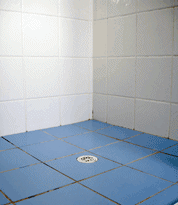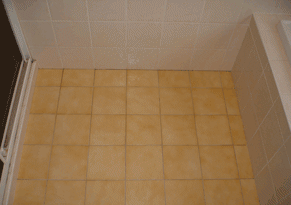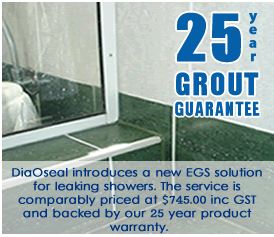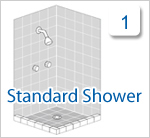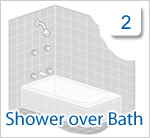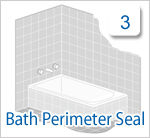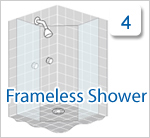Want to know the answer now? Tell us the problem on 1300 366 569. Or work out what’s happened yourself with our DIY leaking shower diagnosis guide.
The commonest cause of a leaking shower is settlement movement in the building. Sometimes you may not be aware there’s a leak - the water may be draining under the house or in an area not often used.
Another main cause is the separation between the floor and wall of the shower recess.
Other reasons include poor quality grouting between the floor and wall tiles, tap penetrations, leaking tap fittings or faulty plumbing.
Why membranes fail.
Most showers today either have a shower tray or waterproofing membrane installed under the shower floor (a building regulation requirement).
There are many potential causes of waterproofing failure. Most fall under four broad areas: design and construction defects, incorrect preparation, application errors and incorrect product selection, and inadequate protection.
When failure occurs water begins to leak into the floor and walls or be absorbed by the woodwork and carpets in the bathroom and adjoining rooms. These damp areas are not only unsightly and smelly, they can onset rot and attract white ants.
Wall and floor separation
Most showers built onto a stud wall will eventually leak because of a gap (expansion joint) developing between the tiled wall and the floor of the shower recess. This gap is caused by the vibration of the wall, arising from the opening and closing of doors, and normal slight movements of the house structure. The grouting between the tiles is not strong enough to resist such expansion, or seal the gap between the floor and the wall. The result is leakage.
Prevent ALL leakage with DiaoSeal
The only solution is to totally prevent water from penetrating the gaps and joints in the shower recess. There are many makeshift solutions to - such as silicone sealants or shower plugging products - but they are temporary, and often difficult to keep clean.
Constant efforts to remove the dirt or mould build up only add to the problem because few sealants are resistant to abrasive powder cleansers and scouring brushes. The coved smooth finish of the DiaOseal product in the corners of the shower recess prevents dirt build up. To date, we’ve never had our seals fail.
In the press.
Sealed for Protection – article from Building Product News, April 2009, quoting DiaOseal general manager, Trent Moreland.
There are various causes of water leaks in a bathroom design, including bad plumbing, faulty seals around the bathtub and shower pan, and badly hung ceramic tiles. However, other factors regarding waterproofing techniques can exacerbate problems.
“A lack of knowledge by contractors and poor product choice are normally the reasons behind leaking bathrooms,” says Trent Moreland, general manager for DiaOseal.
“Failure can be attributed to many careless factors such as not covering the membrane during and after curing to prevent any scuffing or penetration should another trade enter the area. “After all, look at the cost of placing new rubber underlay over your floor membrane, in comparison to the cost of rectifying any failure issues which arise after occupancy.”
Moreland says that in new developments, the failure of sub- contractors to ensure that the finished floor levels are ascertained prior to the fixing of the water stops, as well as to ensure leak control flanges and puddle flanges are recessed into the floor substrate, is often a recipe for disaster.
“Adequate substrate fall to the waste prior to any application of membranes, in many cases, causes membrane emulsification,” he says. Bond breaking is another step that is often overlooked and contributes to membrane failures due to movement.
“But movement is not a contributing factor if the bond breaking has been applied correctly in conjunction with an appropriate membrane material and application,” Moreland says.
Want to take advantage of Trent’s expertise? Ask for him on 1300 366 569.
|
|


